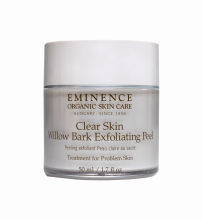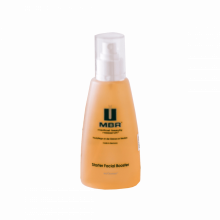Hyperpigmentation and Treatments
Hydroquinone
According to most medical journals, hydroquinone is considered the foremost topical ingredient for inhibiting melanin production. Its components possess potent antioxidant abilities. Hydroquinone is viewed as the most effective topical treatment for skin lightening. There have been numerous clinical studies and research done on its effectiveness and also its possible side effects. Hydroquinone does not actually bleach the skin. Instead, it works by attacking a certain enzyme, tyrosinase, which is crucial to melanin production. It usually takes a few weeks to see a significant change in the skin pigmentation since the existing melanin has to be removed by natural exfoliation. For this reason, hydroquinone and other melanin inhibiting agents are sometimes combined with powerful alpha hydroxy acids (AHAs), which aid in exfoliation. This does increase the risk of skin irritation since each of these, in itself, is a potential skin irritant. This is especially true when the concentration is higher than 4%. Many times, if this percentage is used, cortisone will be added as an anti-inflammatory ingredient. Hydroquinone can be unstable in cosmetic formulas. When it is exposed to air or light, it can turn to a strange shade of brown. If you are considering purchasing a hydroquinone product, it is important to buy one packaged in a non-transparent container so that its exposure to air and light is minimal. A product that is packaged in a jar is not recommended for this reason. Hydroquinone can be purchased over-the-counter in concentrations of 0.5-2%. Anything higher than this requires a prescription. With short-term use, side effects tend to be mild, especially when a lower concentration is used. However, animal studies have shown that high dosages have the potential to cause cancer. For this reason, its use is banned in many countries, including France. It can also cause, however rare, a condition known as ochronosis, a bluish-black coloring of the tissue.
Continuing research is needed to evaluate the risks associated with hydroquinone use and determine the appropriate and safe doses. High-dosage, long-term use may cause cancer in laboratory mice does not necessarily correlate to the same outcome in humans. Hydroquinone treatment has been used successfully by millions of people over many decades. Until their further study is conducted, it may be prudent to use the lower percentage concentrations of hydroquinone unless there are compelling indications for the higher dosage. Then it should only be administered under close medical supervision. At this time, there is no substantial evidence of serious risks when using the lower concentrations of hydroquinone and using it in a short-term manner. However, it is important to keep up with the clinical studies and follow the developments concerning hydroquinone.
Arbutin
Arbutin is derived from the leaves of bearberry, cranberry, mulberry, or blueberry shrubs and is also found in most pears. While some consider it a unique skin-lightening product, it is actually very similar to hydroquinone. It, too, attacks the enzyme tyrosinase, which then suppresses the body’s production of melanin. However, Arbutin appears to have fewer side effects than hydroquinone at the same concentrations. This is perhaps due to its more gradual release into the system. It generally is available in concentrations that range from 3-7%.
Arbutin is considered gentler to the skin than hydroquinone, so, therefore, it causes fewer skin irritations. However, concentration protocols have yet to be established for arbutin, meaning it is not known how much is needed to lighten skin when added to a cosmetic formulation. Many cosmetic companies use plant extracts that contain arbutin. Still, there is little research showing that the plant extract source of arbutin impacts the skin, especially in the tiny amounts used in cosmetics.
Kojic acid
Kojic acid is a naturally occurring substance produced and found in many species of fungi, especially Asperigillis oryzae, which has the Japanese name koji. Kojic acid is a by-product in the fermentation process of malting rice for the manufacturing of sake, the Japanese rice wine. Some research indicates that kojic acid is effective in inhibiting the production of melanin. However, kojic acid can also be unstable when used in cosmetic formulations. Upon exposure to air or sunlight, it can turn brown and lose its efficacy. To help alleviate this product, many cosmetic companies use kojic dipalmitate as an alternative because it is more stable. However, there is an ongoing debate about whether this formulation is as effective in skin lightening as the kojic acid itself. Furthermore, there is controversial research that suggests that kojic acid may have carcinogenic properties in large doses.
Azelaic acid
Azelaic acid is a component of grains, such as wheat, barley, and rye. It is a natural substance derived from a common yeast that lives on normal skin. It is applied topically in a cream formulation at a 20% concentration. It is often used to treat acne, but research shows it to be very effective for skin discolorations. Research also indicates it may be an inhibitor of melanin production. With the recent safety concerns expressed about using hydroquinone, azelaic acid makes a more attractive alternative treatment for melasma and other hyperpigmentation disorders. However, topical azelaic acid has little or no effect on age spots or freckles.
Products containing Azelaic Acid
Glabridin
Glabridin is the main compound found in licorice extract. It, too, is thought to work on the enzyme tyrosinase, which, in turn, inhibits melanin production. It has long been used worldwide as an effective skin lightening agent, and there seem to be little or no side effects associated with its use. However, no clinical studies have been performed on glabridin to establish its effectiveness or optimum concentration successfully.
Products with Liquorice extract (containing Glabridin)
Topical retinoids
Topical retinoids have been successfully used to treat melasma and other skin pigmentation disorders for many years. However, when used alone, they are less effective than hydroquinone, and it may be six months or longer before any noticeable results are realized. They are thought to work by accelerating the natural exfoliation process, the sloughing off of external skin cells. Some believe they may also inhibit the production of melanin, but that is not a well-documented claim.
People who experience hyperpigmentation disorders and do not respond to treatment with hydroquinone alone may have more positive results when tretinoin, a common topical retinoid, is added to the treatment regimen. However, since both of these compounds are potential skin irritants, using them in combination should be done with extreme caution. Again, adding cortisone to the combination of hydroquinone and tretinoin can drastically reduce the amount of skin irritation sometimes associated with their use.
Alpha hydroxy acids
Alpha hydroxy acids, also known as AHAs, primarily in the form of lactic acid and glycolic acid, are the most researched forms of AHAs because they have a molecular size that allows effective penetration into the top layers of the skin. It is generally thought that in and of themselves, AHAs in concentrations of 4% to 15% are not especially effective for inhibiting the production of melanin and will not actually lighten skin discolorations in this manner. Their true benefit lies in their ability to help accelerate cell turnover rates and removing unhealthy or abnormal layers of superficial skin cells, better known as exfoliation. This is where hyperpigmented cells can accumulate, so when the exfoliation process occurs, these hyperpigmented cells are taken away also. However, other research has shown that lactic and glycolic acids can indeed inhibit melanin production in addition to their successful use as exfoliants.
Like laser treatments, alpha hydroxy acid peels may remove skin discolorations using 50% concentrations or greater. Only a qualified physician should perform these types of facial peels.
Products containing Alpha hydroxy acids
Laser resurfacing and chemical peels
Whether performed with a laser or a chemical agent, skin resurfacing may significantly reduce hyperpigmented skin. A chemical peel uses a chemical solution to improve and smooth the texture of the facial skin by removing its damaged outer layers. Alpha hydroxy acids are the mildest of the peel formulas and produce light peels. Trichloroacetic acid (TCA) can be used in many concentrations, but it is most commonly used for medium-depth peeling. Hyperpigmentation problems are generally treated with TCA. The results of a TCA peel are usually less dramatic than and not as long-lasting as those of a phenol peel. In fact, more than one TCA peel may be needed to achieve the desired results. Phenol is the strongest of the chemical solutions and produces an intense peel. It is mainly used to treat people with very coarse facial wrinkles, areas of blotchy or sun-damaged skin, or pre-cancerous growths. Phenol can lighten the treated areas, but it is a powerful chemical and should be used with caution. It is primarily used on the face; scarring may result if applied to the neck or other areas of the body. Because of the high cost, side effects, and inconvenience of chemical peels, these procedures rarely treat hyperpigmentation or hypopigmentation.
Intense pulsed light and nonablative laser
Nonablative laser and light therapy is a relatively novel approach for treating sun-damaged, scarred, or injured skin. This includes hyperpigmentation. High-intensity heat is directed towards the affected areas, eliminating the pigmented lesions without much damage to the surrounding skin. Intense Pulsed Light (IPL) and pulsed dye lasers can both be used to treat hyperpigmentation. On the one hand, there is very little recovery time after undergoing this type of therapy, and people can usually continue with their normal routines. On the other hand, however, these treatments are expensive, and while the effects can be immediate and dramatic, a successful outcome is not always guaranteed.
Cryotherapy
Another alternative to laser treatment is cryotherapy which uses liquid nitrogen. Controlled destruction of the skin cells causes the skin to regenerate itself naturally. For example, excess melanin comes to the surface and peels off in a few days. However, this type of treatment is generally used for small, localized areas of hyperpigmentation, such as age spots. Cryotherapy is just as effective as laser treatments but without the high cost. It also is less likely to cause side effects and is regarded as more reliable.




